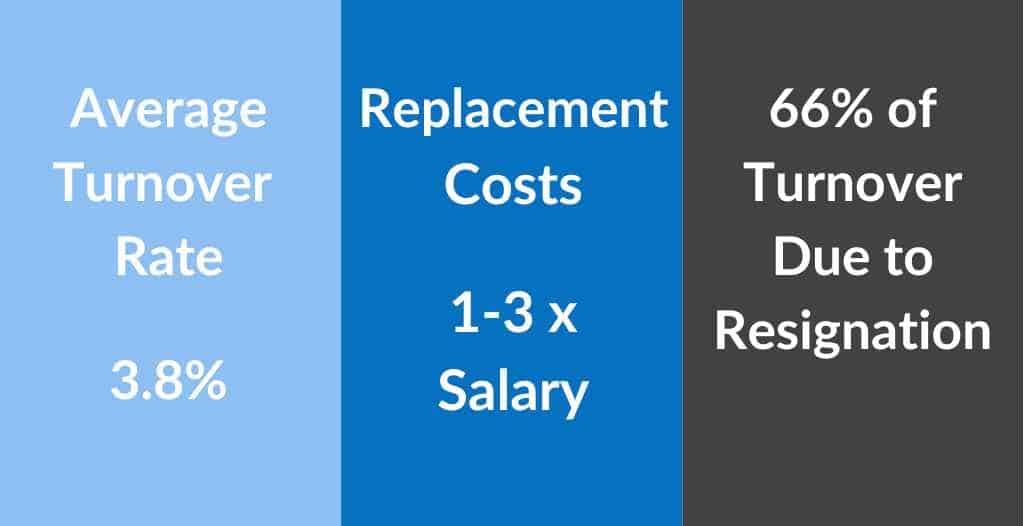Introduction to Employee Retention

One of the key factors in an organization’s success is a talented and committed workforce. Hiring and retaining the right people is essential, ensuring skilled employees who align with the organization’s culture and values.
Table of Contents
ToggleEmployee retention reflects directly on productivity, morale, and the bottom line. Recruiting and retaining top talent is not just a goal but a necessity.
This article offers 20 employee retention strategies to help organizations maintain a robust, engaged, and dedicated workforce, ensuring long-term success and stability.
Developing an Employee Retention Strategy
Understand the Impact of Turnover
When a company experiences low employee retention, mainly when turnover is higher than employee retention, it can face numerous challenges and negative consequences. T
Understanding the common reasons and impacts of employee turnover is key to developing an effective retention strategy that enables the organization to maintain a stable, productive workforce.

Increased Recruitment and Training Costs
Low employee retention rates increase expenses for recruiting, hiring, and training new employees. The costs of advertising job openings, conducting interviews, and onboarding new staff can add up quickly, significantly impacting the company’s expenses. Recruitment agencies, when used, charge from 15% to 25% of the employee’s annual salary.
Onboarding and training new employees to reach the productivity level of their predecessors can also be costly. It’s estimated that it can take 1-2 years for an employee to reach the productivity of an existing staff member. During this period, productivity can decline.
Loss of Institutional Knowledge
Employees take valuable knowledge and experience specific to the company when they leave. This loss of institutional knowledge can lead to gaps in expertise and understanding, particularly in critical areas of operation.
The continuity and quality of work can suffer, as remaining employees or new hires may not have the same depth of understanding about the company’s processes, culture, or client relationships.
Decreased Employee Satisfaction
Low employee retention rates can lead to decreased morale among the remaining employees. Witnessing frequent departures can create a sense of instability and uncertainty, leading to lower job satisfaction and engagement.
Remaining employees may be asked to shoulder the burden of lost employees, causing burnout and loss of work-life balance.
The decreased employee satisfaction results in lowered productivity, as employees may feel less motivated or committed to the organization’s goals.
Reduced Brand Loyalty and Company Reputation

Frequent turnover can harm the company’s reputation, both as an employer and a business, as the quality of service and production fall with lowered employee retention.
Potential candidates may be wary of joining an organization with a high turnover rate, perceiving it as a sign of poor management or low employee satisfaction, while clients and customers may view high turnover as a lack of reliability or consistency in service or product quality.
Loss of Team Dynamics and Collaboration
Regular changes in team composition can disrupt the dynamics and collaboration among team members. Established relationships and efficient workflows can be interrupted, requiring teams to continuously adapt to new members and potentially slowing project progress.
This loss of cohesiveness can further decrease the overall effectiveness and productivity of teams, creating an environment damaging growth and innovation.
20 Employee Retention Strategies
1. Understand Employee Needs
Increasing employee retention requires organizations to recognize the diversity of employee needs, preferences, and motivations.
Regularly engaging with staff through surveys, one-on-one meetings, and open forums allows a deeper understanding of what drives satisfaction and commitment.
This approach enables and can drive necessary changes to benefits, work environments, and career development opportunities, increasing employee retention but organizations must be ready to make the changes driven by employee feedback.
Acknowledging the changing dynamics of personal and professional life, including the desire for better work life balance, flexible work, and remote work helps in creating policies that reflect current employee lifestyles and values, making them feel heard and cared for.
2. Recruitment and Onboarding

The recruitment and onboarding process set the stage for long-term engagement.
Focusing recruitment efforts on cultural fit and long-term potential reduces turnover by ensuring new employees align with the company’s mission and are likely to grow with the organization.
Creating a welcoming and informative onboarding process enables candidates to see and become part of the company culture quickly.
A structured onboarding program introduces new hires to the company’s business strategies, connects them with key team members, and aligns them with business goals and expectations.
3. Competitive Compensation
Competitive salaries and a comprehensive package that includes benefits like health insurance, company contributions towards retirement plans, and performance bonuses are common and effective employee retention strategies.
Generous vacation and paid time off programs also contribute to a healthy work life balance sought by employees and increase employee engagement by providing them an opportunity to rest and recharge.
Finally, companies should also ensure compensation policies don’t limit employees’ financial growth within the company, either during promotion or when employees grow skilled outside of the management track.
4. Work Environment, Culture, and Employee Satisfaction
Cultivate an inclusive, supportive, and motivating work environment that encourages innovation, collaboration, and continuous improvement.
Respect, recognition, and opportunities for employee engagement and professional development all characterize a positive culture. Such an environment fosters employees’ sense of belonging and commitment, reducing the desire to seek opportunities elsewhere.
Encouraging teams to celebrate successes, learn from failures, and work together towards common goals creates a cohesive and resilient workforce, increasing employee retention rates.
5. Professional Development Opportunities
Provide clear paths for advancement and growth within the organization. Training, mentorship, and professional development programs encourage employees to enhance their skills and take on new challenges.
A key employee retention strategy is regular career development discussions and planning sessions with employees. This ensures they see a future within the company, and feel acknowledged for their contribution, increasing employee morale and reducing the likelihood of them leaving for more compelling job opportunities elsewhere.
6. Leadership and Management
Organizational culture plays a key role in employee retention. Leaders and managers must understand and be trained in effective communication, empathy, and support. Leadership skills play are an important non-salary factor as they create a supportive environment for their direct reports and are effective at understanding and addressing team needs.
7. Employee Engagement and Well-being
Effective employee retention strategies rely on initiatives that promote physical, mental, and emotional well-being.
Encouraging work-life balance through flexible hours, remote work options, and wellness programs shows employees that the company values their overall health and happiness.
Engaged employees who feel their well-being is a priority are more productive, happier, and less likely to leave.
8. Employee Retention Strategies and Initiatives
Organizations can boost employee retention by developing targeted workforce analysis and feedback programs to help them understand different employee segments and their needs.
By making retention efforts strategic and data-driven, organizations can more effectively invest in the areas that will significantly impact employee loyalty. For example, organizations may need to provide increased career development for high potentials, flexible scheduling and remote work options for working parents, or wellness initiatives for all employees.
9. Adaptation to the Modern Workforce

Companies should stay attuned to changing workforce trends and expectations, such as the increasing desire for flexible work arrangements, a greater emphasis on diversity and inclusion, and a shift towards more purpose-driven roles.
Organizations that adapt their policies, culture, and benefits to reflect these trends are committed to current and future employee needs. Their reward is higher employee retention based on great employee satisfaction.
10. Continuous Assessment and Feedback
Organizations should regularly evaluate their results through surveys, exit interviews, and performance data to ensure an effective employee retention strategy.
They should encourage and act on ongoing feedback from employees to understand their concerns and suggestions. This continuous loop of feedback and adaptation ensures that retention strategies remain effective and responsive to the changing needs of the workforce.
11. Regular Performance and Salary Reviews
A critical part of the continuous assessment and feedback process includes conducting regular performance appraisals and adjusting compensation to ensure employees are paid fairly for their work.
This goes a long way towards increasing employee job satisfaction by making sure employees feel recognized and valued for their contributions.
12. Recognition and Reward Programs

Employee retention strategies that include recognition programs and reward employee contributions, with formal awards or even a public thank-you offering company-wide recognition, help many teams retain employees.
Acknowledging individual and team successes regularly boosts morale, creates a culture of excellence, and reinforces positive behaviors.
These programs should be varied and inclusive, ensuring that all types of contributions are celebrated and employees feel valued and appreciated.
13. Flexible Work Arrangements
Flexible schedules, remote work options, and more flexible hours can be an important part of a company’s benefits package and help meet the diverse needs and lifestyles of the workforce, helping to retain employees.
This flexibility can significantly enhance job satisfaction and loyalty, particularly among employees who value autonomy and the ability to balance professional and personal responsibilities effectively.
14. Fostering a Sense of Belonging
Initiatives that build a strong sense of community and belonging within the organization have also been shown to result in increased employee retention.
Encourage the formation of interest groups, celebrate cultural events, and facilitate team-building activities.
A strong sense of belonging and community helps build a robust internal network that supports collaboration and knowledge sharing.
Fewer employees quit when they feel connected to their colleagues and the organization, as they are more likely to have a positive view of their workplace and a desire to stay.
15. Professional Development and Training
Employee retention strategies should include investing in many professional development opportunities for employee growth. Employees should be encouraged to pursue new skills and qualifications through workshops, seminars, online courses, and tuition reimbursement programs.
Providing a clear roadmap for advancement and regularly discussing career aspirations ensures employees feel the organization is invested in their long-term success and growth.
16. Transparent Communication
Open and honest communication channels at all levels of the organization are critical to the corporate culture. Employees should be updated frequently on company news, changes, and developments while encouraging open dialogue and feedback.
Transparent communication fosters a culture of trust and inclusivity, where employees feel informed and involved in the organization’s journey.
17. Health and Safety Initiatives
Prioritize the physical and mental health of your workforce by implementing comprehensive health and safety protocols.
Employee benefits should include access to mental health resources, ergonomic workspaces, and health and wellness programs. Demonstrating a commitment to the overall well-being of employees not only reduces health-related absences and turnover but also boosts morale and productivity by showing that the organization cares about its most valuable asset: its people.
18. Empowering Employees
Autonomy and innovation are essential ways of encouraging employees to take ownership of their work and contribute ideas.
Empowerment helps build employee engagement and leads to a more engaged and committed workforce, as employees who feel they have a personal stake in the organization’s success are more likely to go above and beyond in their roles.
19. Exit Interviews and Alumni Network
One way to improve employee retention is to understand the viewpoint of the departing employee. Thorough exit interviews should be conducted with all employees leaving the company to understand the reasons employees quit, using this information to refine retention strategies.
Maintaining a positive relationship with former employees through alumni networks can lead to potential rehires and referrals.
These networks also serve as a valuable source of feedback and can enhance the company’s reputation as a desirable place to work.
20. Monitoring and Responding to Industry Trends
Leadership should stay abreast of industry compensation standards, emerging job roles, and evolving employee expectations and regularly assess and adjust retention strategies to align with these trends, ensuring that the organization remains competitive and appealing as an employer.
Being proactive in responding to industry shifts demonstrates to current and prospective employees that the organization’s ability to be forward-looking and committed to maintaining a dynamic and relevant workplace.
How to Implement Employee Retention Strategies Effectively
Implementing employee retention strategies requires a deliberate and systematic approach that begins with assessing current retention rates and employee satisfaction levels.
Companies need a clear understanding of where they stand regarding retention and turnover rates and objectives for their retention goals that define success, whether it’s improving overall retention rates, enhancing job satisfaction, or reducing turnover in critical departments.
Leadership should be involved at every stage to ensure managers across all levels are equipped and committed to executing these strategies.
These objectives and their benefits should be communicated to the entire organization, encouraging open dialog about them to cultivate a supportive environment.
Finally, it’s important measure the impact of changes made and be prepared to make continuous adjustments based on feedback and changing conditions.
Innovative Employee Retention Strategies Case Studies
Many companies are continually innovating to attract and retain top talent. Here’s a look at how four industry leaders – The Trade Desk, Netflix, Whole Foods, and Clif Bar & Company – have each developed unique strategies that exemplify commitment to employee satisfaction and organizational growth, showcasing their diverse approaches to fostering a loyal and productive workforce.
The Trade Desk
The Trade Desk’s collaboration with Blueboard represents a pioneering approach in employee recognition by offering unique, hand-curated experiences as rewards ranging from adventurous outings to relaxing retreats for work anniversaries.
Recognizing the significant milestones in their employees’ journeys with the company, they have scaled their efforts to ensure each member of their growing team feels individually valued.
By offering a variety of experiences, The Trade Desk has managed to cater to the diverse interests of their workforce, fostering a culture of appreciation and personal investment in the company’s success.
Netflix

At Netflix, the focus has always been cultivating a high-caliber team by hiring only ‘A’ players. This selective process is centered around identifying individuals who excel in their field and embody the company’s values and culture, providing significant value to the company.
By implementing policies that treat employees like adults, such as a simplified expense policy and offering unlimited vacation time, Netflix has created an environment of trust and autonomy.
These strategies have been instrumental in building a motivated, efficient, and satisfied workforce, contributing significantly to the company’s innovative output and industry dominance.
Whole Foods

Whole Foods has set itself apart in the retail industry by creating a values-driven culture that deeply involves employees in decision-making.
Their distinctive, egalitarian structure encourages every team member to contribute to corporate decisions, thereby enhancing their commitment and satisfaction.
By aligning the company’s core values with those of its employees, Whole Foods has managed to maintain a remarkably low employee turnover rate, proving that a concerted focus on shared values and employee empowerment can lead to exceptional retention.
Clif Bar & Company

Clif Bar & Company is renowned for its outstanding 97% retention rate, a testament to its commitment to building a culture of ownership and personalized development.
Introducing an employee stock option program has been central to fostering this sense of ownership, aligning employee success with the company’s growth.
Clif Bar’s focus on personalized growth plans also illustrates their commitment to supporting each employee’s journey, contributing to high levels of satisfaction and loyalty.
This dual strategy of investing in both the personal and professional growth of employees has solidified Clif Bar’s reputation as a leader in employee retention.
Realizing Success
The success of a company’s retention efforts will be reflected in organization’s overall performance, culture, and reputation and requires a multifaceted and evolving approach.
By understanding and addressing the diverse needs of the workforce, leadership can build a more resilient, engaged, and productive team.





